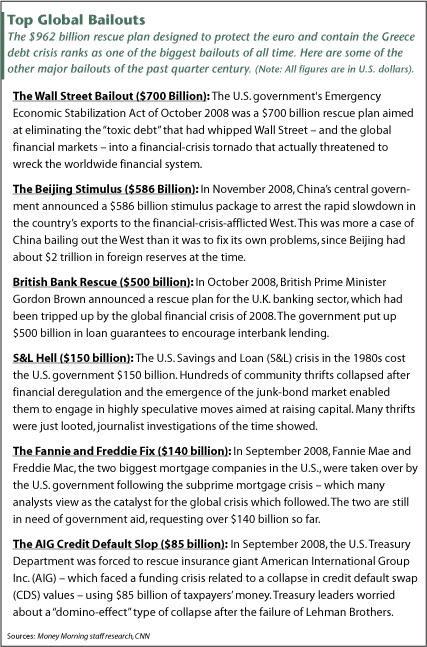European Union (EU) finance ministers yesterday (Monday) announced a $962 billion (750 billion euros) Eurozone bailout package that rallied global markets with a drastic new attempt to prevent a euro collapse and contain the Greek debt crisis.
European policy makers agreed to the massive effort in a 14-hour meeting Sunday, trying to beat the start of Asian markets. The aid plan will include $77 billion (60 billion euros) from a European Union emergency fund (the first lifeline to be tapped for aid), $562 billion (440 billion euros) from Eurozone governments, and $320 billion (250 billion euros) from the International Monetary Fund (IMF) to be disbursed on an as-needed basis.
"The decision took much longer than expected, but for once the scope of the actions unveiled dwarfed previous leaks and speculation: this is shock and awe part two and in 3-D, with a much bigger budget and a more impressive array of special effects," said Marco Annunziata, chief economist at UniCredit Group.
Analysts say this latest package bought European Union (EU) leaders some more time to steady the rocky markets, after weeks of offering smaller aid packages that did little to instill investor confidence.
 The most recent plan includes the European Central Bank (ECB) buying debt of troubled Eurozone nations - mainly Greece, Portugal and Spain - to stabilize the credit markets. It will sell other bonds to balance out its holdings.
The most recent plan includes the European Central Bank (ECB) buying debt of troubled Eurozone nations - mainly Greece, Portugal and Spain - to stabilize the credit markets. It will sell other bonds to balance out its holdings.
The United States is re-opening dollar swap lines, through which it lends dollars to the ECB in exchange of euros, making dollars available to European banks who had become reluctant to lend to each other. U.S. involvement could help protect U.S. banks from taking hard hits should a Eurozone country default: The top 10 U.S. banks have $3.1 trillion exposure to Europe.
So far the short-term effects of the deal have been successful: The yield on Greek ten-year bonds fell by 468 basis points Monday to narrow the spread to benchmark German bunds to 481 basis points - down from 965 at the end of last week. Portugal and Spain's bond prices were also up, along with European bank shares.
The FTSEurofirst 300 Index of top European shares climbed 7.4% by the close after falling 8.9% last week. The Dow Jones Industrial Average - after last week's roller coaster ride - closed up 404.71 points at 10,785.14. The Standard & Poor's 500 Index was up 4.40% and Spain's IBEX 35 Index rallied 14.4%.
The euro rose 0.3% to $1.2803.
Long-Term Concerns
Despite Monday's market performance, the jury is still out on whether or not the effort will finally be enough to reverse the euro's fall and stop the debt contagion.
"Global asset markets are effectively turned on their head as the week gets under way, but the full scale of the E.U. rescue and the details of who pays what will need careful examination before we conclude whether there is some longevity and scope for full recovery beyond the initial relief," said Kenneth Broux, market economist at Lloyds TSB.
One concern is the availability of the 440 billion euro emergency funds. If individual government approval is needed for disbursement there could be resistance and fund release delays.
Analysts also feel the euro will continue to face downward pressure.
The plan "will do no more than pad the euro downside against a sharp collapse rather than turn it around," Alan Ruskin, chief international strategist at RBS Securities who sees the euro hitting low $1.20s by summer's end, told Reuters.
There also needs to be effective implementation of long-term fiscal policies to make the aid offer work. One key step is to chop down the debt and spending of the troubled nations.
Most Eurozone members have already exceeded the maximum budget deficit ceiling of 3% of gross domestic product (GDP) that's supposed to be allowed by the group. Spain plans to cut its deficit this year to 9.3% of GDP and to 6.5% in 2011, down from 11.2% in 2009. Portugal will cut its debt to 7.3% of GDP, down from 2009's 9.4%.
Analysts are waiting to see if the troubled "PIIGS" of the Eurozone create and enforce strict enough austerity measures to meet deficit reduction goals but also keep enough investor confidence to stop the need for bailouts.
"[The bailout] does not address the underlying issue - the terrible economic growth prospects of the southern eurozone countries and Ireland," Simon Tilford, chief economist at the Centre for European Reform think-tank, told Financial Times. "Unless these economies can avoid deflation and get their economies growing, they have no future in the eurozone."
News and Related Story Links:
- Reuters:
"Shock and awe" package lifts euro markets - MarketWatch:
Unclear if EU "shock and awe" will provide lasting relief - Financial Times:
Markets rally on EU bail-out - Money Morning News Archive:
Greece Stories - Money Morning News Archive:
Debt Contagion Stories - Money Morning News Archive:
PIGS Stories


